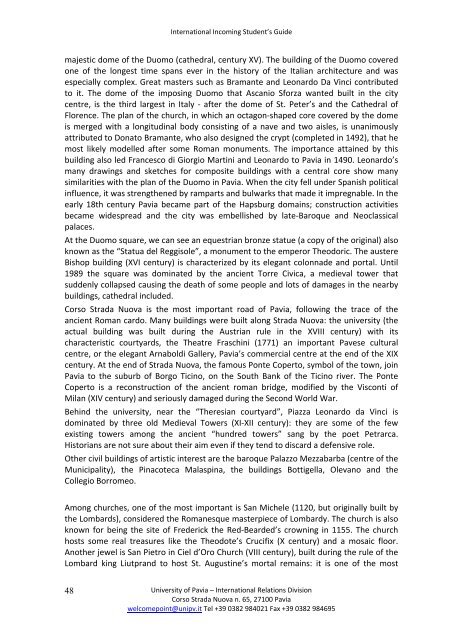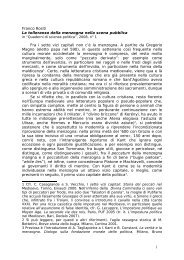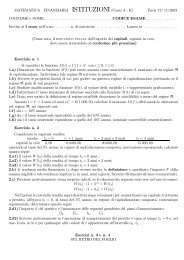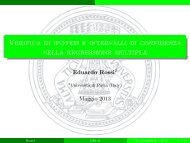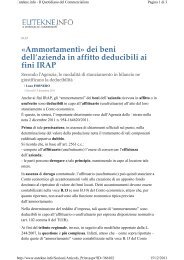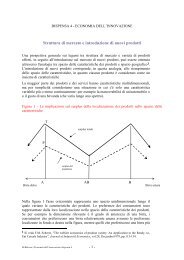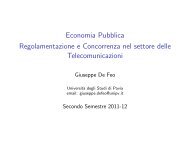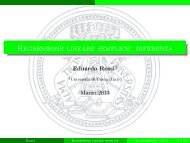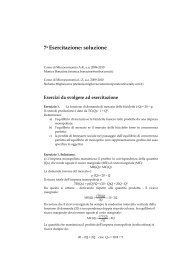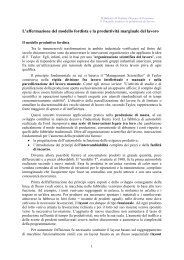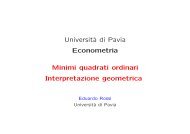International Incoming Student's Guide - Università degli studi di Pavia
International Incoming Student's Guide - Università degli studi di Pavia
International Incoming Student's Guide - Università degli studi di Pavia
Create successful ePaper yourself
Turn your PDF publications into a flip-book with our unique Google optimized e-Paper software.
<strong>International</strong> <strong>Incoming</strong> Student’s <strong>Guide</strong><br />
majestic dome of the Duomo (cathedral, century XV). The buil<strong>di</strong>ng of the Duomo covered<br />
one of the longest time spans ever in the history of the Italian architecture and was<br />
especially complex. Great masters such as Bramante and Leonardo Da Vinci contributed<br />
to it. The dome of the imposing Duomo that Ascanio Sforza wanted built in the city<br />
centre, is the third largest in Italy ‐ after the dome of St. Peter’s and the Cathedral of<br />
Florence. The plan of the church, in which an octagon‐shaped core covered by the dome<br />
is merged with a longitu<strong>di</strong>nal body consisting of a nave and two aisles, is unanimously<br />
attributed to Donato Bramante, who also designed the crypt (completed in 1492), that he<br />
most likely modelled after some Roman monuments. The importance attained by this<br />
buil<strong>di</strong>ng also led Francesco <strong>di</strong> Giorgio Martini and Leonardo to <strong>Pavia</strong> in 1490. Leonardo’s<br />
many drawings and sketches for composite buil<strong>di</strong>ngs with a central core show many<br />
similarities with the plan of the Duomo in <strong>Pavia</strong>. When the city fell under Spanish political<br />
influence, it was strengthened by ramparts and bulwarks that made it impregnable. In the<br />
early 18th century <strong>Pavia</strong> became part of the Hapsburg domains; construction activities<br />
became widespread and the city was embellished by late‐Baroque and Neoclassical<br />
palaces.<br />
At the Duomo square, we can see an equestrian bronze statue (a copy of the original) also<br />
known as the “Statua del Reggisole”, a monument to the emperor Theodoric. The austere<br />
Bishop buil<strong>di</strong>ng (XVI century) is characterized by its elegant colonnade and portal. Until<br />
1989 the square was dominated by the ancient Torre Civica, a me<strong>di</strong>eval tower that<br />
suddenly collapsed causing the death of some people and lots of damages in the nearby<br />
buil<strong>di</strong>ngs, cathedral included.<br />
Corso Strada Nuova is the most important road of <strong>Pavia</strong>, following the trace of the<br />
ancient Roman cardo. Many buil<strong>di</strong>ngs were built along Strada Nuova: the university (the<br />
actual buil<strong>di</strong>ng was built during the Austrian rule in the XVIII century) with its<br />
characteristic courtyards, the Theatre Fraschini (1771) an important Pavese cultural<br />
centre, or the elegant Arnabol<strong>di</strong> Gallery, <strong>Pavia</strong>’s commercial centre at the end of the XIX<br />
century. At the end of Strada Nuova, the famous Ponte Coperto, symbol of the town, join<br />
<strong>Pavia</strong> to the suburb of Borgo Ticino, on the South Bank of the Ticino river. The Ponte<br />
Coperto is a reconstruction of the ancient roman bridge, mo<strong>di</strong>fied by the Visconti of<br />
Milan (XIV century) and seriously damaged during the Second World War.<br />
Behind the university, near the “Theresian courtyard”, Piazza Leonardo da Vinci is<br />
dominated by three old Me<strong>di</strong>eval Towers (XI‐XII century): they are some of the few<br />
existing towers among the ancient “hundred towers” sang by the poet Petrarca.<br />
Historians are not sure about their aim even if they tend to <strong>di</strong>scard a defensive role.<br />
Other civil buil<strong>di</strong>ngs of artistic interest are the baroque Palazzo Mezzabarba (centre of the<br />
Municipality), the Pinacoteca Malaspina, the buil<strong>di</strong>ngs Bottigella, Olevano and the<br />
Collegio Borromeo.<br />
Among churches, one of the most important is San Michele (1120, but originally built by<br />
the Lombards), considered the Romanesque masterpiece of Lombardy. The church is also<br />
known for being the site of Frederick the Red‐Bearded’s crowning in 1155. The church<br />
hosts some real treasures like the Theodote’s Crucifix (X century) and a mosaic floor.<br />
Another jewel is San Pietro in Ciel d’Oro Church (VIII century), built during the rule of the<br />
Lombard king Liutprand to host St. Augustine’s mortal remains: it is one of the most<br />
48<br />
University of <strong>Pavia</strong> – <strong>International</strong> Relations Division<br />
Corso Strada Nuova n. 65, 27100 <strong>Pavia</strong><br />
welcomepoint@unipv.it Tel +39 0382 984021 Fax +39 0382 984695


